Can Anything Fix a Broken City?
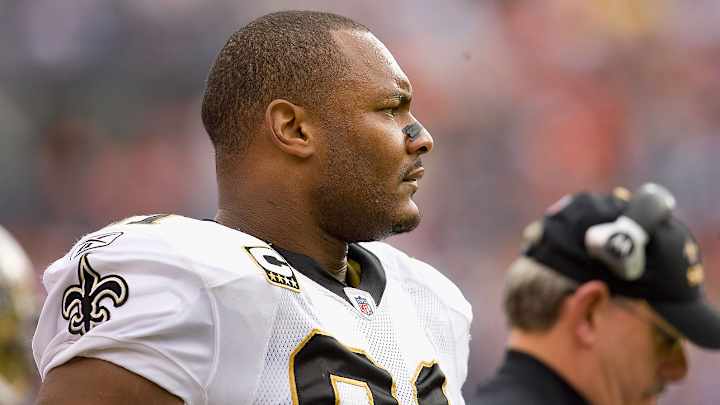
NEW ORLEANS — At 10:45 p.m. Saturday, former New Orleans Saints running back Deuce McAllister texted with Pierre Thomas, a former teammate. Thomas said he and a group of friends including another ex-Saint and close friend, Will Smith, were headed downtown after a meal of tuna sashimi and kumamoto oysters at Smith’s favorite sushi spot. McAllister, who had taken his kids to the Suns-Pelicans NBA game, had tucked them into bed and settled on the couch. He decided against meeting the group, and now McAllister can’t escape the notion he could have peeled himself off the couch and somehow tilted the cosmos. Instead, he spent part of Sunday morning explaining to his six-year-old son that his classmate’s father had gone to heaven.
“Maybe they would’ve waited on me,” an exhausted McAllister said Tuesday. “You wonder what difference two minutes would’ve made. One minute. Thirty seconds. It wasn’t meant to be.”
At 11:30 p.m. Saturday, two bodies fell in the Lower Garden District of New Orleans, an up-and-coming neighborhood south of the French Quarter on the banks of the Mississippi. The male victim, the beloved former player and budding philanthropist Smith, lay slumped in the driver’s seat of his Mercedes SUV, his legs emerging from the open door. The New Orleans coroner later determined that he’d been shot eight times, seven in the back and once in the left side of his chest, with several bullets piercing vital organs. His wife, Racquel—Rockie for short—was struck twice by .45 slugs, once in each leg, before crawling for cover, her thighs dragging across the pavement under the live oak trees that canopy the passing cars where Sophie Wright Place meets Camp Street.
• NEW ORLEANS MOURNS:Peter King talks to Drew Brees in wake of Will Smith’s death
Just before 6 a.m. Sunday, Saints coach Sean Payton drove the eight blocks from his house to the scene of the shooting, long after the nearby Half Moon Bar, an airy dive serving tap beer and po’ boys, had cleared of stunned patrons, and long after the police had paused their extensive canvass of the neighborhood. Unable to sleep after learning of the death of his former player, Payton stood in silence under the green glow of a streetlight. Fans had already begun placing handwritten signs and Saints gear on a fence at the intersection. Payton heard the shutter of the traffic signal click, paint the scene yellow, then red, and he pondered the Crescent City’s 31st murder of 2016.
The coach would later describe New Orleans as “broken.” When a shooting happens in one of the predominantly black, impoverished Lower 9, Payton told USA Today, the city takes little notice.
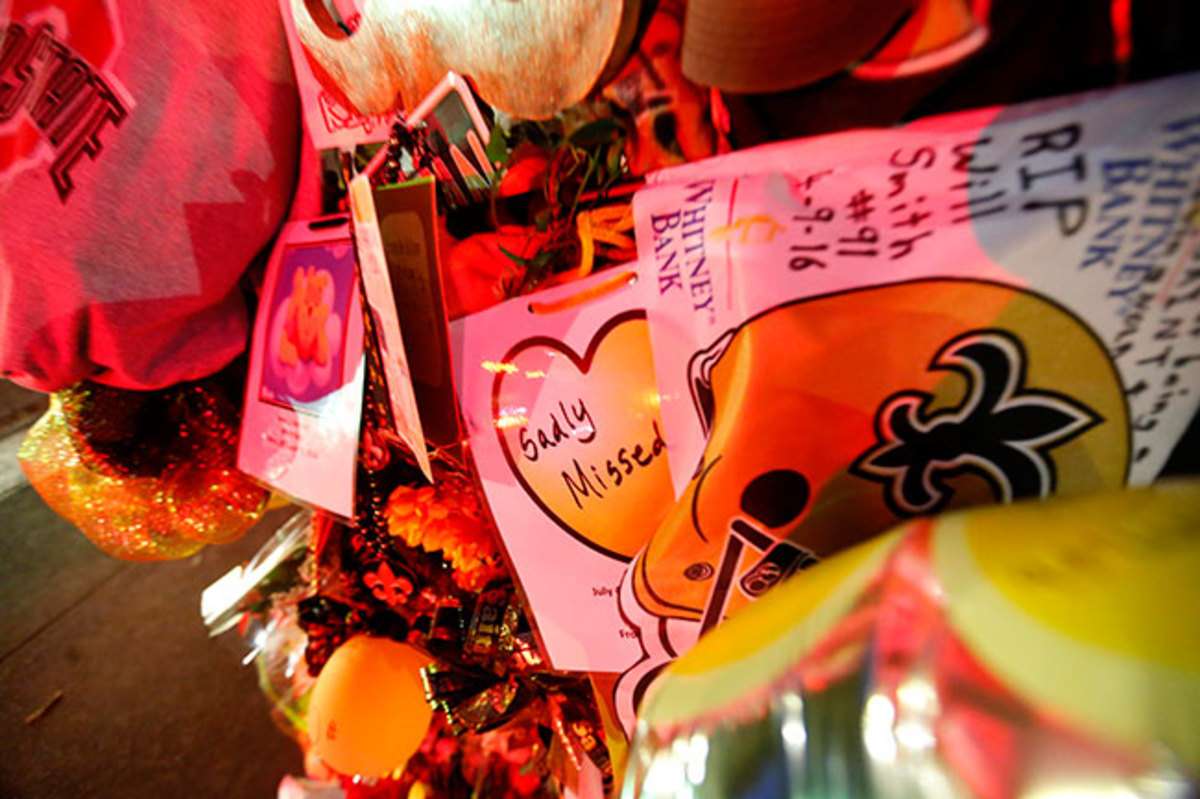
At approximately 7:37 p.m. Sunday, an unidentified shooter tested that theory. While Rockie was recovering from a five-hour surgery at the University Medical Center, the 32nd body of 2016 dropped, this one in the 7th Ward. A 31-year-old male, later identified as Bryant Brastfield, lay on his back in lush, moist grass, dead eyes staring up at the I-10 overpass. There was a momentary flurry of activity—a coroner’s truck, a search for witnesses, the wails of heartbroken relatives—then all returned to normal in this neighborhood peppered with abandoned cars, discarded tires and gutted, rotting homes. There would be no three-day canvass for witnesses here in the 7th Ward, no inventory of surveillance cameras. The mayor would not visit a grieving relative, as he had visited Rockie while she recovered from gunshot wounds and a broken femur. At North Roman and Allen Street, no one could recall the name of the man who died here less than a week ago—not the corner boys in white tees taking a midday fried chicken break, nor the teens passing out fliers for an impending fish fry, nor the man fresh off a hospital stay, picking boiled crabs with his teeth and spitting portions of shell off his deck.
“It happens once or twice every moon,” the man said. “I don't concern myself with why.”
Bodies fall here. Life goes on.
At 8 p.m. Monday, down the road at the Smoothie King Center before the Timberwolves-Pelicans tip, the PA announcer asked for a moment of silence for Will Smith, the New Yorker who met a girl from Lafayette, La., and made a life in New Orleans. That life was over after 34 years. The moment of silence ended, and nobody knew what to do. Then someone in Section 114 shouted “Who Dat?!” And a relieved chorus of fans responded, “We Dat!!”
Later that night, Saints defensive end Cameron Jordan shuttled between luxury suites in the arena, posing for pictures with fans and connecting with friends. Still bewildered at the loss of a former mentor, the kid from Minnesota reflected on his adopted city.
“You love the city for what it is,” he said, “but you also realize the city for what it is. This is one of the most violent cities in the country. Why wouldn’t you be scared?”
* * *
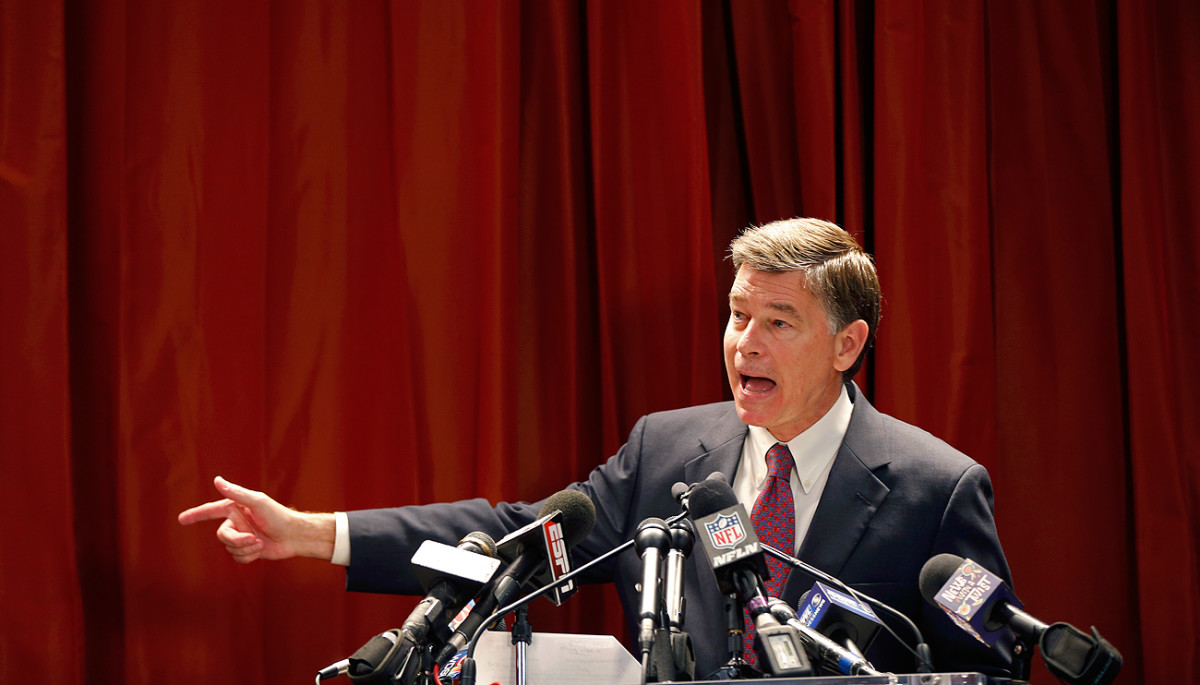
On Wednesday afternoon, with more than two dozen members of the media gathered in a conference room at the hospital Rockie was rushed to after suffering bullet wounds to both legs, Smith family attorney Peter Thomson outlined the version of events he has come to understand concerning the encounter between Will Smith and Cardell Hayes on Magazine Street that resulted in Smith’s death. Thomson cited various sources he’d spoken to, including but not limited to Rockie. He declined to name others.
Some six hours later, at the steps of his law practice on Poydras Street, John Fuller announced his decision to turn down an appointment for a district judgeship so that he could continue to defend Hayes, who has been charged with second-degree murder. Fuller said he intended to see the case played out in court, not in the media. “Cardell Hayes was convicted before I got out of church Sunday morning,” Fuller said.
As of Thursday, these facts were not in dispute:
Hayes, driving down Magazine Street in his Hummer H2 with a companion in the passenger seat, came to a quick stop and was lightly rear-ended by the Mercedes SUV piloted by Smith. Video footage then shows Hayes pulling over to the right and Smith accelerating past the Hummer to the left. Hayes’s car then follows Smith’s.
“I don’t know what the situation was,” said Johnson, “but if it got escalated, I know Will probably wouldn’t back down.”
Both parties agree that Hayes then rear-ended Smith several blocks down the road at a stoplight. That’s where versions differ. Fuller says it was an accident on the part of Hayes as he tried to get the SUV’s license plate for police; Thomson characterizes it as an assault.
Smith then got out of the car, and words were exchanged between the two parties. At some point, Rockie got between the two men. According to Thomson, it was as Smith returned to his vehicle that Hayes opened fire on the couple.
A key point of contention centers on the loaded 9mm handgun police later found in Smith’s car. Thomson says he is not aware of any account in which Smith retrieved the weapon or had any intention to retrieve the weapon. But an as-yet unidentified man who claimed to have witnessed the attack, speaking in a video taken in the moments after the incident, says the shooting victim had moments earlier said he had a gun.
Said McAllister: “I can’t say that that was surprising as far as Will having some kind of protection.”
“He wouldn’t back down for nothing,” said Saints defensive line coach Bill Johnson, who worked closely with Smith for most of his career. “I don’t know what the situation was, but if it got escalated, I know Will probably wouldn’t back down.”
Thomson insisted Smith never brandished a gun that night. Fuller, the lawyer for Hayes, claims to have a witness that puts a gun in Smith’s hand during the encounter. According to video evidence from the Half Moon bar, which a manager released to the police and media, it took approximately four minutes for police to arrive on the scene after the shooting. Fuller suggests that in the four minutes between the shooting and the arrival of police, a former NOPD officer who was at the scene committed “untoward” behavior, delaying the recovery of Smith’s weapon from the vehicle. In response, a New Orleans Police Department spokesman said the car had been towed to a secure location to execute the search warrant, which was why there was a delay in discovering Smith’s gun. (A third gun, from Hayes’s vehicle, was also recovered.)
In an interview with WWL-TV, Ex-New Orleans police officer Billy Ceravolo, one of Smith’s dining partners that night, says he was several minutes ahead of the group, in another car, and arrived on the scene minutes after the shooting, after receiving a call from Pierre Thomas. The ex-officer does not elaborate on what he did once he got there.
The back-and-forth among the accused’s representative, the victims’ lawyer and the police has become par for the course in a case that promises to grip the city and the region for many months.
* * *
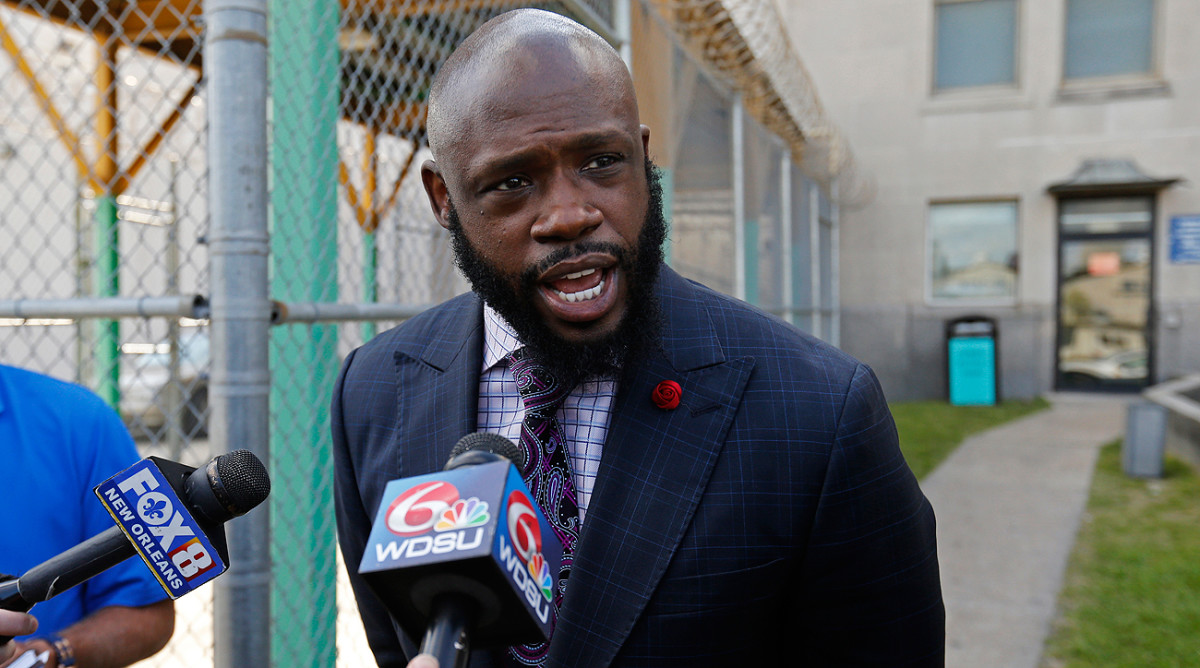
Perhaps the most perplexing aspect of the case, which seems to yield new public details every few hours, is the connection between Hayes and Ceravolo, a close friend of Smith’s. Ceravolo was one of six police officers involved in the shooting death of Hayes’ father, Anthony, outside a drugstore in 2005, not far from the scene of Smith’s killing.
On Dec. 26, 2005, Anthony Hayes was seen carrying a four-inch knife while walking down a sidewalk, after arguing with a drugstore clerk. When confronted by police, Hayes refused to drop the blade and could not be incapacitated by pepper spray (none of the officers carried tasers). Police say Anthony Hayes then lunged at an officer, and the group opened fire, striking him nine times.
New Orleans police have said they are investigating the connection between Ceravolo and Hayes but so far don’t have any reason to believe Smith was targeted.
In 2011 the city settled federal lawsuits filed by both Cardell Hayes and his half-sister, Tyiece Baptiste-Howard, against the city and the six cops. Hayes sought $4 million; the final settlement was $100,000 apiece. A departmental source who worked on the city’s defense in the lawsuit said he had no recollection of Cardell Hayes harassing or otherwise contacting the officers involved in his father’s death before or after the settlement. Reached at home, former NOPD officer Christian Varnado, one of the six officers involved in the shooting, who keeps in touch with Ceravolo, said he hadn’t heard from Hayes and characterized the connection as “just happenstance.”
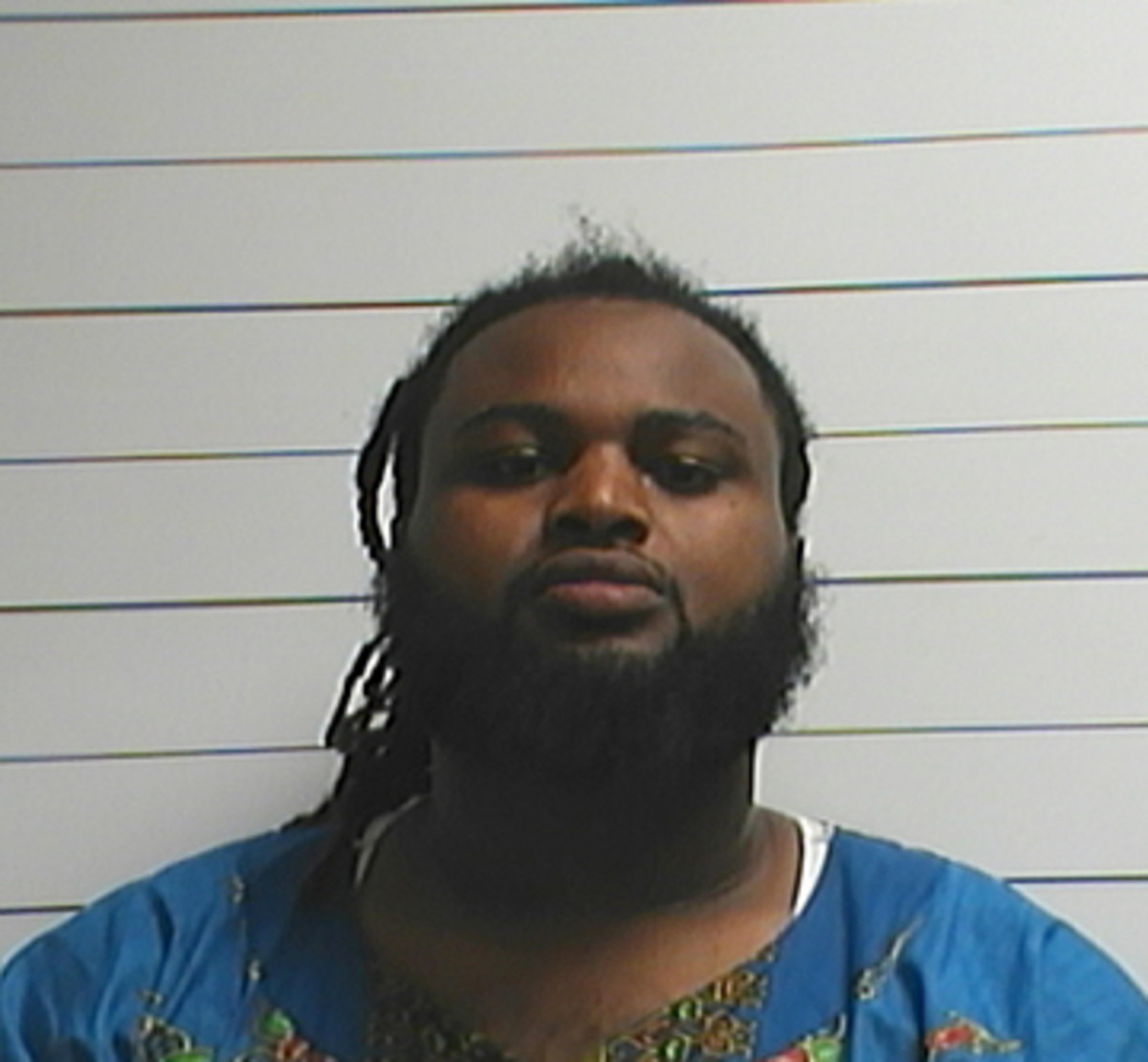
“The city never should’ve settled [the lawsuit], because we did everything right,” said Varnado, who left the department in 2012 and now works as a fitness coach in Metairie. “You would think if [Cardell Hayes] had some sort of vendetta we would've heard something by now.”
On Aug. 1, 2010, the year before he reached the settlement with the city, Hayes was arrested on Dorgenois Street for driving with a loaded pistol and prescription codeine in a red Chevy SUV. When questioned about the pills, according to police reports, he said he was delivering them on behalf of his aunt to a cousin who had been shot. Reached by phone by officers, the aunt said she gave the pills to Hayes for personal use, “for his headaches.” The gun, a P345 Ruger, was recovered with a full clip and a bullet in the chamber, along with two additional 16-round clips of .45 caliber ammunition. Hayes eventually pleaded guilty to a weapons charge and received a six-month suspended sentence.
Hayes was high school football standout at Warren Easton High just east of Treme and was recruited by several FBS schools. He is listed in state records as an executive for a tow truck company and a separate company which breeds small dogs. Lately, the 28-year-old had been playing football for the Crescent City Kings of the Gridiron Developmental Football League.
“Didn’t take football as serious as he could have,” Fred Washington, the team’s head coach, told USA Today. “That could’ve paid for a good education, so on and so forth.”
* * *
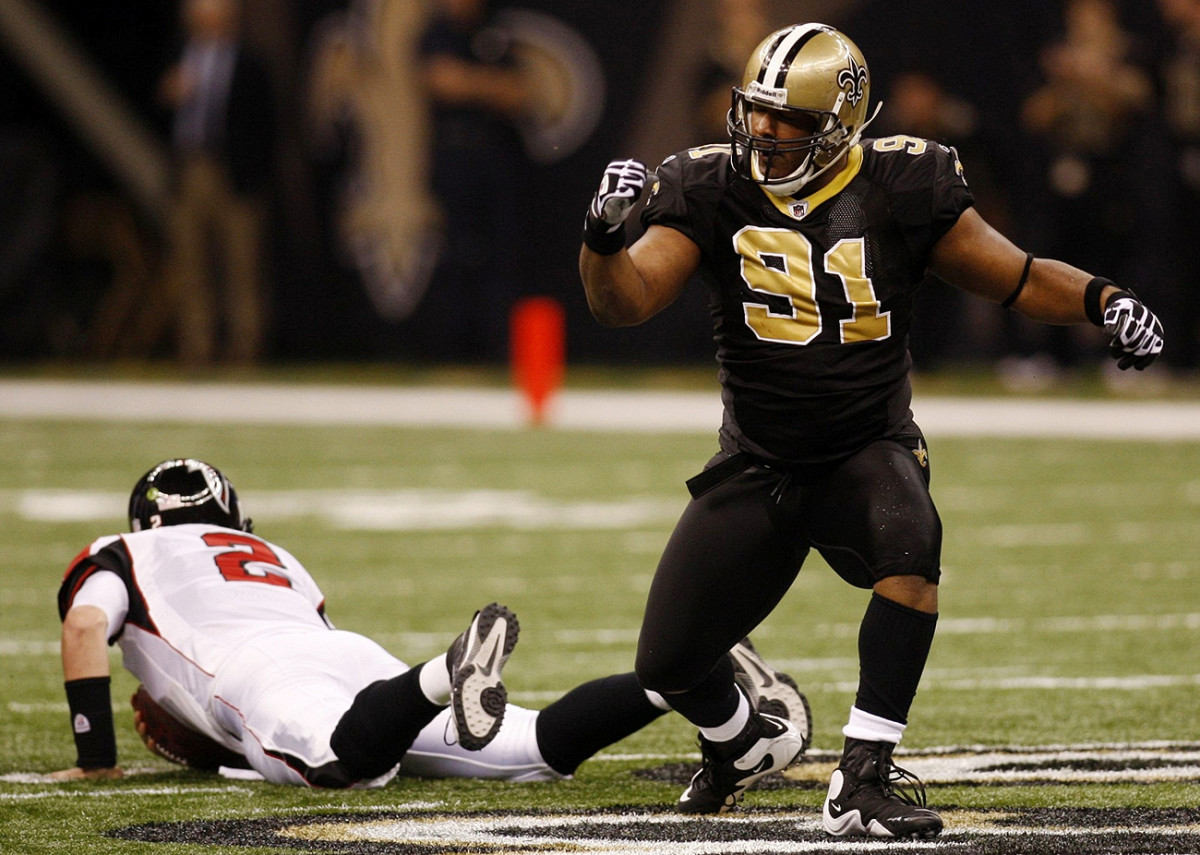
Ruby Smith, 81, saw the news on television Sunday morning at her home in the Fairgrounds neighborhood. As a single grandmother taking care of three children on her own, she met Will and Rockie four years ago through Kingsley House, a non-profit that manages the mixed-income community in which Ruby Smith lives. Kingsley House has hosted a “Santa With the Smiths” event since 2009, for which Will and Rockie and their friends provide Christmas gifts for 20 needy families. They met Ruby four years ago and insisted she be involved in every function.
“They were beautiful in and out,” Ruby says. “He really gave back to the community. He and his wife were just unusual.”
Ruby’s story must have struck a chord with Will—he lost his mother to breast cancer at age 4 and was raised predominantly by a grandmother.
“He fell in love with this city, and New Orleans embraced him as much as he embraced it.”
For the three children in Ruby’s care, ranging in ages from 8 to 12, Will and Rockie and their friends provided bicycles, video games, jackets, underwear, pajamas and, one year, bibles to replace a family bible lost during Hurricane Katrina. Ruby said the eight-year-old also saw the news of the shooting on television and grew confused.
“My little one doesn’t quite understand it,” Ruby says. “She said she couldn’t understand why they would shoot Racquel, because she was so pretty.”
Terrell Haynes, program director at Kingsley House, said several families had been calling him Sunday and Monday to confirm that the news was real.
“New Orleans grabbed him,” Haynes said. “And he and his wife, they made a commitment to stay here and give back to the city. He fell in love with this city, and New Orleans embraced him as much as he embraced it.”
Beyond his philanthropic efforts, which included extensive work with a substance-abuse rehabilitation program in the city, Smith appeared to be at a life crossroads with what friends describe as endless opportunities. He was contemplating a coaching internship offer from the Saints for the summer. He had just completed an MBA at the University of Miami. He had previously considered careers in business and law enforcement after his football career ended in August 2014; New England cut him six months after he’d been released by the only team he’d ever played for, the Saints.
“His options were without a doubt unlimited,” McAllister says. “The guy would surprise you as far as intellect was concerned. You could talk about politics, the stock market, investments. You wouldn’t get your normal football answer.”
Smith, a captain and defensive stalwart on the Saints team that won a Super Bowl following the 2009 season, was one of the lone holdovers from the pre-Katrina Saints. Scott Shanle, a special-teamer in New Orleans for seven seasons, arrived from Dallas with new coach Sean Payton in 2006.
“Before we got there, there was dysfunction,” Shanle says. “There wasn’t a lot of winning. Even though Will was a holdover, he was exactly what we were looking for. Tough, smart, selfless.”
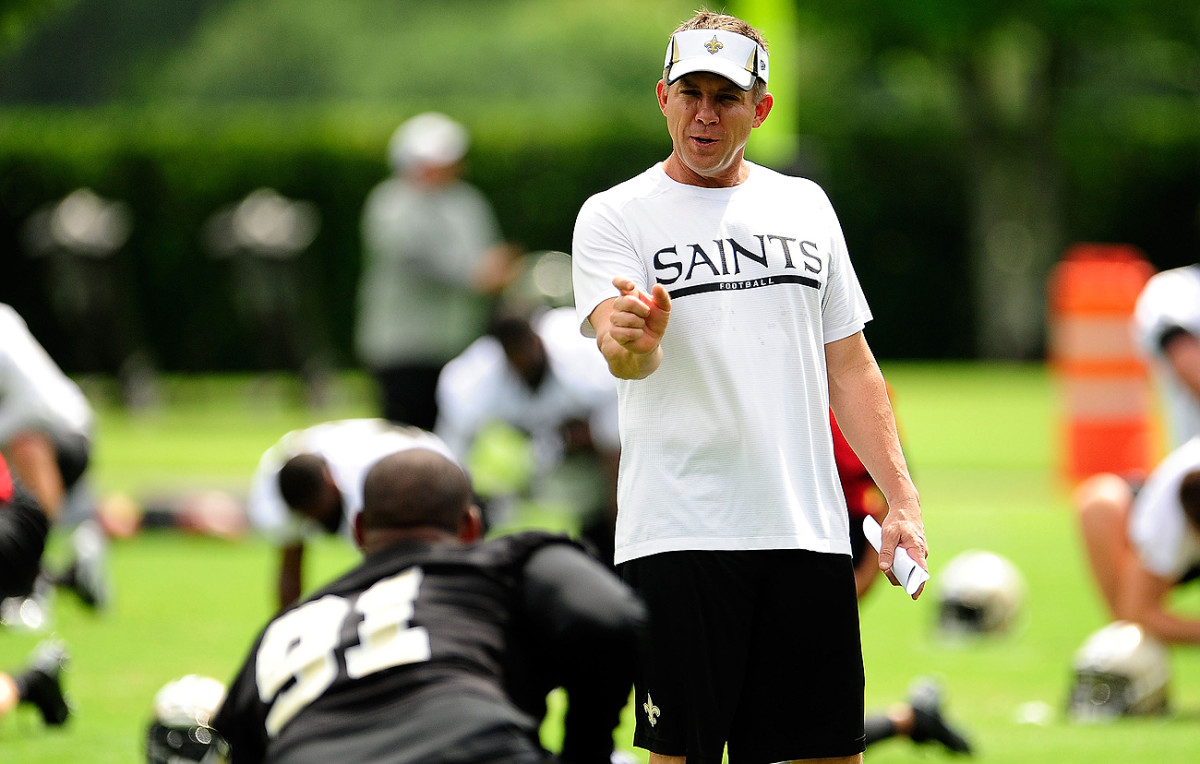
Smith had been a pre-draft favorite of Bill Johnson, the defensive line coach who was with the Falcons in 2004 when the Saints drafted Smith 18th overall, out of Ohio State. In 2005, when the team was playing its home games in San Antonio’s Alamodome as a result of Katrina, the Falcons beat the Saints on a late field goal, and Johnson looked up to see Smith charging at him from the New Orleans sideline.
“I never will forget, he was sprinting right after me, after the game. And I was like, man, Will Smith’s mad,” Johnson recalled. “He starts telling me how bad they were going to beat us next time around. He was mad about that loss and he was telling me the whole way, ‘You just wait.’ They did beat us the next year, twice.”
Johnson was among a group of coaches and ex-players including Joe Vitt, Payton, Brian Young and Mike McKenzie and McAllister who visited Racquel during her hospital stay. (She has since been discharged.)
“You lose him, she has to tell her kids, and she’s dealing with an injury? That’s a lot on a young lady,” Johnson says. “We just sort of made sure that everybody knew we were thinking about them and anything we could do for them.”
Former Saints receiver Marques Colston entered the league as a seventh-round pick in 2006, the year Payton began to turn things around. The Saints’ all-time leader in catches, receiving yards and touchdowns recalls long talks in the sauna with Smith about what it took to make it in the NFL.
“One of the more difficult things to do in pro football is to garner enough respect for other grown men to follow you,” Colston says. “His demeanor and the way he worked and carried himself made it easy to follow that example. He was someone whose opinions I always respected.”
The core of Colston, Smith, Drew Brees, Jonathan Vilma, Jahri Evans, Roman Harper, Darren Sharper and Smith brought New Orleans its first and only Super Bowl win four years after Katrina. Smith had married Racquel a year and a half earlier, with Smith bringing a child from a previous relationship. Together they have two children.
“He was always talking about them,” said ex-Saints linebacker Will Herring. “To think that they’re moving forward without a dad is terribly sad, and, frankly, it ticks you off. To think somebody thought they had the right to take that from them… I sure hope he gets the justice he deserves.”
The youngest of Smith’s children, seven-year-old Wynter, accompanied his father last season to see a Saints game, where he met former teammates and coaches. He went back to school that week and bragged to classmates that his father was friends with Mr. Payton and Mr. Brees.
On Monday, when Payton and other Saints staffers visited Racquel in the hospital, the coach held her hand and promised her that it would not be the last time her son visited Saints headquarters.
“You’re always going to be a part of this family,” Payton told her.
* * *
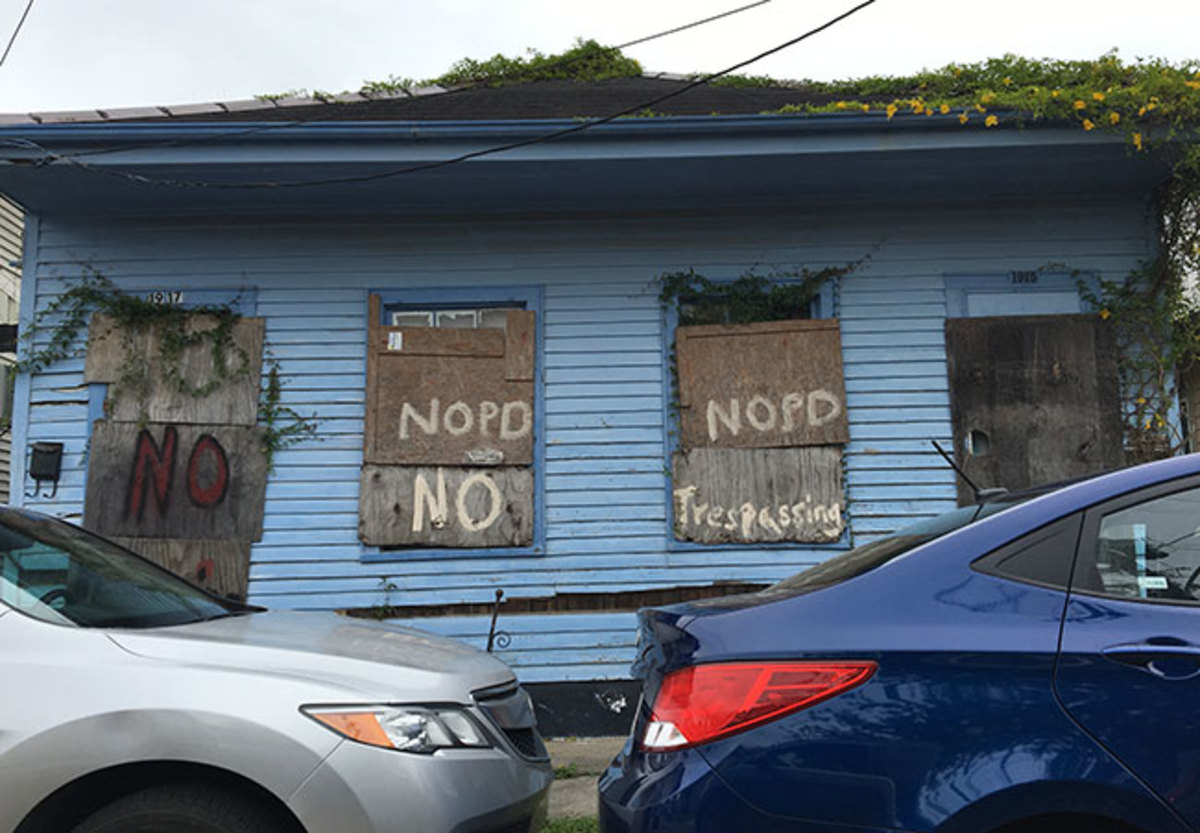
In 2015, New Orleans logged homicides at a rate of just over 41 per 100,000 people, making it the fourth-deadliest place to live in the United States, behind St. Louis, Baltimore and Detroit. About half of the 32 murders in 2016 have occurred in the 7th, 8th and 9th wards, clustering around the Treme neighborhood where Bryant Brastfield fell on Sunday.
In the Lower Garden District, residents have been shaken by what feels like increasing violent crime. In November, a Tulane medical student was shot in the belly while trying to stop a robbery a block-and-a-half from where the Smiths were shot. Video surveillance of the area showed the attacker then aiming his pistol as the student’s head and pulling the trigger—the gun jammed.
Tammie Carpenter is a manager at the Half Moon Bar, where patrons set down their Purple Haze bottles and flooded into the street to investigate Saturday night’s gunfire. “You can’t have million-dollar homes, rising rent, and have muggings, shootings, stabbings and robberies once a week,” she says.
“People feel that murders just don’t matter in their community. We have to do better.”
When shootings and stabbings occur at intersections like North Roman and Allen, however, they don’t garner the attention that Smith’s shooting death has brought on the city’s culture of violence.
“It speaks to class,” says councilwoman LaToya Cantrell, who represents District B, which includes the Lower Garden District. “You have a high-profile professional individual who was considered a hero in the city, and neither the police response nor the attention was parallel. You really can’t justify it; life is life.
“It does send a message in the community… People, especially the loved ones of the victim, feel that way—that murders don’t matter in their community. We have to do better, but these actions speak to violence across the country and not just New Orleans.”
The cash-strapped city has struggled not only in preventing crimes in communities like Treme, but in prosecuting them. Last Friday an Orleans Parish judge ordered the release of seven inmates facing felony charges who had languished in detention because the government could not muster funds for public defenders for them. Wrote Criminal District Court Judge Arthur Hunter in his 11-page ruling: “The defendants’ constitutional rights are not contingent on budget demands.” Among the charges the seven face are second-degree murder, rape and armed robbery. The men are being held pending an appeal from the district attorney.
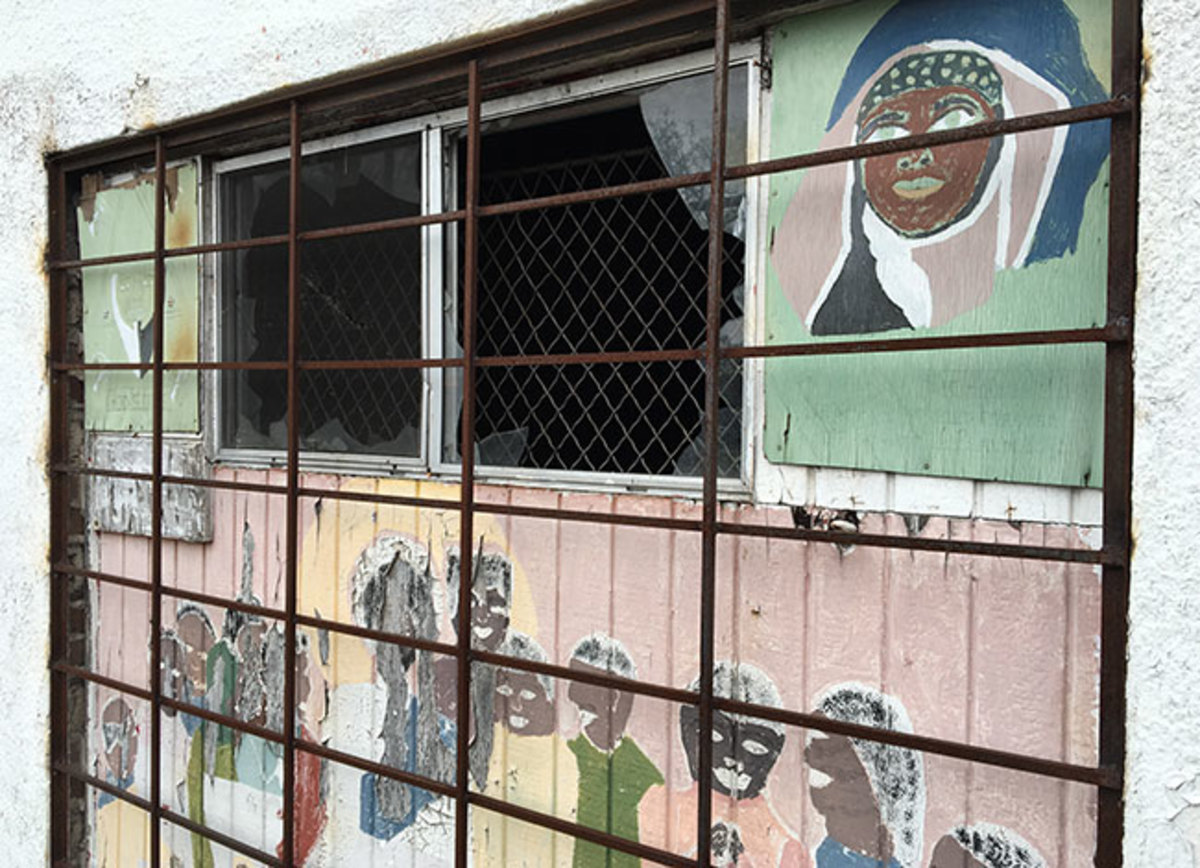
Hayes, meanwhile, is the focus of a high-priority investigation that his attorney argues has biased public opinion against his client. Said Fuller: “This case is the ultimate example, the absolute ultimate example, of a person being pre-judged.”
Much of the outrage in New Orleans over Smith’s shooting stems from a local reverence for Saints players, enhanced by the post-Katrina Super Bowl and stoked by the continued success of the team under Payton and Brees. Many of Smith’s teammates were incredulous at Fuller’s assertion that Hayes, a football player himself, didn’t recognize Smith. Fuller says Hayes collapsed in his chair when notified on Sunday that the man he had shot was the former Saint.
“I think this really shocked not only the players but the fans,” McAllister says. “It’s like there was an unwritten rule as far as Saints players. Celebrity status. It’s unbelievable the love they have for you here. How did that escalate to that point? I’m not saying the individual did not know who Will was, but it’s hard for me to believe you didn’t know.”
Based on what information has been revealed thus far, one can anticipate Hayes’ defense. Louisiana has long had what are known as “castle laws,” among the strongest self-defense codes in the country. Castle laws grant citizens the right to use deadly force to protect themselves on their property or in their car, provided the property owner “reasonably believes” there is a threat of death or severe bodily harm and that the subsequent amount of force used is “reasonable and apparently necessary to prevent such offense.”
Ed Reynolds, a former NFL player and Army reservist who worked in security for the NFL from 2000 to ’08, advised players annually on gun laws in their state. He says it’s common for players to carry a gun in the car, though many carry hunting rifles. “Being around a weapon tends to give you false courage,” Reynolds says. “It tends to be when you have a weapon, eventually, if you end up in a situation, you are going to go get it. And you should never grab a weapon unless it is for the purpose that you are going to use it.”
Said Cantrell, the District B councilwoman: “I think there needs to be a real focus on conflict resolution from the league and from all of us.”
Until the concussion crisis and domestic violence took hold of the national consciousness, the popularity of guns among NFL players was a hot-button issue for the league, with a spate of player arrests in the mid 2000s. It's a topic that will be raised in the media and revisited if Hayes goes to trial.
Smith’s was the kind of death that sent shockwaves through the NFL community, and gut-punched another community for which random murders were becoming the status quo.
“It happens all the time,” says Tammie Carpenter, the manager at the Half Moon Bar, “but when it’s a Saint it’s different, because the NFL fans are so diehard, so hopefully it makes some impact.”
Still, there were no politicians or activists gathered over the weekend on Sophie Wright Place to take advantage of a moment of national media scrutiny, as one might have found in another city. The death of a local icon had, as yet, prompted no meaningful calls for stricter gun control laws or sentencing mandates, other than those coming from Sean Payton. It’s fair to wonder—if someone pumping eight bullets into a Super Bowl hero and local do-gooder isn’t going to muster up momentum to do something, what will?
At the makeshift memorial for Smith, amid the flowers, Saints gear and handwritten notes, a lone sign echoed Sean Payton’s broken city diagnosis and calls for change. In red and white, it read, “Stop the Violence.”
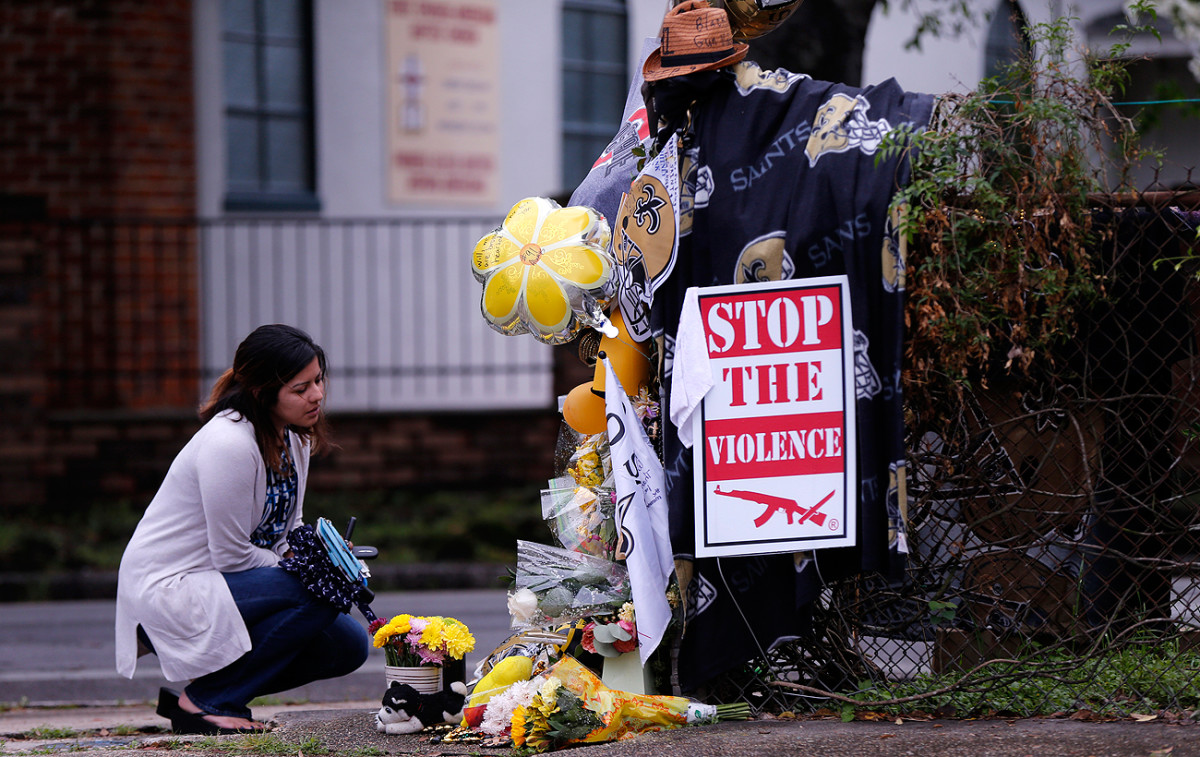
• Questions or comments? Email us at talkback@themmqb.com.
